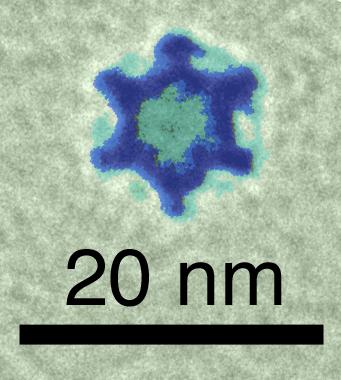Head of the Center for Nanotechnology at the university Prof. Uri Benin:
This is a breakthrough that can help diagnose diabetes and use solar energy to create "green fuel"

A new type of nanometer-sized particles (nanometer = billionth of a meter) similar in shape to the Star of David, was recently discovered by researchers from the Center for Nanoscience and Nanotechnology of the Hebrew University. According to the researchers, the discovery will help in the development of new methods for detecting glucose in the diagnosis of diabetes as well as in the process of utilizing solar energy and turning it into clean fuel.
The researchers of the Hebrew University, whose research was recently published in the prestigious journal Nature Materials, believe that the discovery will have a decisive contribution in the development of complex nanoparticles that combine different materials in the same particle. Such a combination of materials gives complex nanoparticles a variety of functions.
The particles in the shape of the Star of David were created by the research group led by Prof. Uri Benin, who heads the Center for Nanoscience and Nanotechnology in the Faculty of Natural Sciences at the Hebrew University, while they were trying to develop new types of nanoparticles (particles whose size is 10,000 times smaller than the width of a human hair) A person).
The researchers were engaged in the development of new nanoparticles made of two types of materials connected to each other. Until this discovery, scientists were only able to produce nanoparticles in which another substance contains the other (similar to an egg and yolk) as well as nanoparticles in which a certain substance forms islands on top of the other (similar to the head of a match on the surface of the matchstick). In this research, a surprising thing happened when Prof. Benin's postdoctoral student, Dr. Janet MacDonald, tried to produce nanometric particles composed of copper sulfide (a cheap and common semiconducting material) and a ruthenium-type metal known for its excellent chemical properties. Contrary to expectations to take the form of "islands", the researchers discovered that the particles they created are striped and Star of David-like, in fact they created the first "nano-Star of David".
After the surprising discovery, the researchers tried to understand the three-dimensional structure of the new particles. It took several months to unravel the mystery with the help of Dr. Maya Bar Sadan and Dr. Luther Hauben from the Biolich Research Center in Germany. The researchers created a three-dimensional image of the particles using an electron microscope and discovered that the Star of David-shaped structures are actually "nano-cages". These are nanoparticles in the form of a crystal with a cross section of 6 sides (hexagonal). Each particle has a tiny metal frame that surrounds it like a bird's cage but a hundred million times smaller in size. Due to the hexagonal shape of the cross-section, the particles appear to have the shape of a Star of David when viewed from above - a shape that no researcher has seen so far.
The research on the possible applications of the nano Star of David is only in its infancy but already shows that the structures are not only beautiful but that the composition and shape of the cage also makes them extremely useful. The first application that the researchers demonstrated is in the field of diagnostics - they coated an electrode with nanocages and proved that tiny amounts of hydrogen peroxide can be detected using the new device. The discovery of hydrogen peroxide is the first step in the development of better glucose sensors and this has important medical consequences, including in the diagnosis of diabetes. It turned out that a cage made of two materials was essential for the creation of the sensitive device - a similar device with only copper sulfide nanoparticles did not work and only the combination with the surrounding metal cage and the properties of the copper sulfide, acted as a sensitive detector.
Prof. Uri Benin and his research team have high hopes for the possible applications of the nanometer-sized Star of David particles, and the research team is now checking whether these materials can be used as sensors for medical and other environmental purposes, and whether they can be used to turn solar energy into "green fuel" .
Prof. Benin will be one of the lecturers At the Nano Israel conference that will be held in Tel Aviv on November 6-8.

14 תגובות
Only the visa will protect us from the criminals of Jehovah's army.
It is the planet Venus and a million and one other symbols of goddesses and gods.
No one cheers for ruthenium? It is simply excellent "and made of a ruthenium type metal known for its excellent chemical properties"
Soon a crescent will be added - nano particle - binational :-)
Thanks Adi
This particle is also Palestinian for hundreds of generations that the Jews settled on it
Haha - you took my comment...
May his name be praised forever
Soon a dome-shaped nanoparticle in the shape of a Streimel
And also of a certain organ in the body that has been circumcised.
Ilan (2) - You're right, it bothers me too. But in searching the web in English (I wanted to see the XNUMXD structure) I saw that this is the common title. You can understand that a less yellow title would be much longer and more complicated, and forgive them this time 🙂
Ilan (4) - What is ironic is that people use high words in foreign language without understanding their meaning.
What's ironic about that?
Hahahahaha what's ironic here that the Jews were the first to get the Star of David, maybe as number 1 says soon the Hamsa (:
Please forgive my ignorance (I'm quite new to the site) but what does it matter what shape it has? The main thing is the utility or the similarity to the symbol?
soon! Hamsa-shaped graphene! Only at the Hebrew University! do not miss!